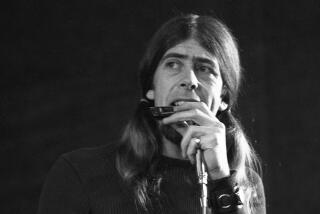Set Marks Art Pepper’s Final Comeback
Art Pepper was an authentic Los Angeles jazz original. Born in Gardena in 1925, his career was immersed in almost every aspect of Southland jazz, from Central Avenue--which was still vibrant in his early years--to a starring role in the Stan Kenton Orchestra, to showcase participation in the West Coast jazz explosion of the ‘50s and beyond.
At his best, Pepper’s alto sax sound was instantly identifiable. His warm tone was countered by a brisk rhythmic style energized by brief, dramatic pauses followed by sudden bursts of notes. The years on Central Avenue gave him an unusual empathy for the blues, and he embraced the harmonic extensions of bebop without sacrificing his method of phrasing.
All alto saxophonists of Pepper’s generation were confronted by the titanic presence of Charlie Parker. Most responded by adopting as much of Parker as they could in their playing. But Pepper--like Lee Konitz and Paul Desmond--insisted on his own path. Using Lester Young, with elements of Parker, as a model, adding qualities that were inimitably his own, Pepper forged a style that is still compelling and original. Today, when the emphasis on revisiting the Parker/Miles Davis/Dizzy Gillespie-dominated styles of the ‘40s and ‘50s is far too prevalent, it is a distinct pleasure to hear an artist who seemed incapable of being anything other than himself.
“I’ve never studied, never practiced,” he says in his intimately revelatory 1979 autobiography, “Straight Life: The Story of Art Pepper” (written with his wife, Laurie Pepper). “I’m one of those people, I knew it was there. All I had to do was reach for it, just do it.”
Unfortunately, in the process of reaching, Pepper’s numerous accomplishments were interrupted in the ‘50s, ‘60s and ‘70s by lengthy incarcerations for drug-related offenses. (He only recorded twice between 1961 and 1975.) By the mid-’70s, when he embarked on what was to become a significant comeback, there were few who believed he could once again rise to the peaks of his earlier playing.
But, amazingly, Pepper prevailed. And a just released five-CD boxed set, “Art Pepper: The Hollywood All-Star Sessions” (* * * * , Galaxy/Fantasy), affords a far-reaching view of a fertile artistic imagination that was still brilliantly alive only a few brief years--in some sessions, only a few months--before his death in 1982 in Panorama City.
Initially released on the Japanese label Atlas, the sessions were nominally led by others--Bill Watrous, Pete Jolly, Jack Sheldon, Sonny Stitt, Shelly Manne and Lee Konitz. But the dates were actually Pepper’s, unidentified as such because of his contractual commitment then to Galaxy. Released as seven LPs, they have never before been available in the U.S. on CD.
The music can only be described as bountiful, with Pepper placed in a series of surroundings that trigger virtually every aspect (big-band playing aside) of his musical skills. Liner notes by his widow add useful anecdotal personal insights.
In the first session, from 1979, Pepper performs with trombonist Watrous in the front line, accompanied by the rhythm section of pianist Russ Freeman, bassist Bob Magnusson and drummer Carl Burnett. The attraction is the marvelous interplay between Pepper’s stutter-step rhythms and the virtuosic articulateness of Watrous, their simpatico lines comfortably crossing back and forth through standards and spontaneous jams.
The second session, from 1980, places Pepper in a quintet with trumpeter Sheldon, pianist Milcho Leviev, bassist Tony Dumas and drummer Burnett (a frequent Pepper associate). West Coast jazz of the ‘50s comes alive in this sequence, with the arrangements and soloing instantly reminiscent of the cool-sounding, contrapuntally-tinged music of the period.
The third session, also from 1980, is more intimate, with Pepper joined only by the rhythm section of pianist Jolly, drummer Roy McCurdy and again bassist Magnusson. Given the opportunity to display his ballad wares, Pepper offers a stunning reading of “You Go to My Head,” in which his occasionally jagged, disjunct phrases, with their brief moments of hesitancy, become the generating energies beneath a penetrating emotional expressiveness.
The fourth session, again from 1980, takes a dramatically different route. Partnered with Stitt, the hard-swinging bebop alto saxophonist, Pepper unleashes a more aggressive mode, tossing licks back and forth in a fashion that recalls late-night Central Avenue jam sessions. Two rhythm sections offer support for the dates, which took place during a four-day period: pianist Lou Levy, bassist Chuck Domanico and drummer Burnett on the first; pianist Freeman, drummer Burnett and bassist John Heard on the second. One of the more gripping outings features an intense encounter between Pepper and Stitt on “Lester Leaps In,” with both playing tenor sax.
Session five, from 1981, revisits the West Coast sound of the ‘50s, with Watrous again present, as well as tenor saxophonist Bob Cooper, pianist Jolly, bassist Monty Budwig and drummer Manne.
But the most consistently engaging set of performances is from session six, recorded in 1982, with Pepper joined by Konitz on alto sax, pianist Mike Lang, drummer John Dentz and Magnusson returning on bass. The rare encounter between Pepper and Konitz, who, along with Paul Desmond, offered what were arguably the most significant alternatives to the Charlie Parker hegemony, is filled with marvelous playing, individually and in tandem.
On Konitz’s “A Minor Blues in F,” the two engage in an unaccompanied passage in which ideas are tossed back and forth with wild abandon. “Cherokee” generates similar interaction at an up-tempo, filled with spontaneous combined soloing, so creative that it sometimes sounds like an updated Bach two-part invention. And on “The Shadow of Your Smile,” Konitz plays an utterly astonishing opening chorus, a definitive example of the powers of simplicity and directness, followed by Pepper’s warm and expressive soloing on clarinet, an instrument he should have played more often.
There are a few sluggish moments in the overall mix--to be expected over six sessions and five CDs--but for the most part this is premier jazz, performed by one of its premier artists. And the music’s subtext--the remarkable capacity of Pepper to not only survive but to triumph over the numerous terrors that coursed through his life--is optimistic testimony to the survival of an indomitable spirit. *
More to Read
The biggest entertainment stories
Get our big stories about Hollywood, film, television, music, arts, culture and more right in your inbox as soon as they publish.
You may occasionally receive promotional content from the Los Angeles Times.










